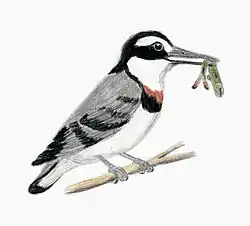Shengjingornis
| Shengjingornis Temporal range: Early Cretaceous
| |
|---|---|

| |
| Holotype specimen | |
| Scientific classification | |
| Kingdom: | Animalia |
| Phylum: | Chordata |
| Class: | Reptilia |
| Clade: | Dinosauria |
| Clade: | Saurischia |
| Clade: | Theropoda |
| Clade: | Avialae |
| Clade: | †Enantiornithes |
| Family: | †Longipterygidae |
| Genus: | † Li et al., 2012 |
| Type species | |
| †Shengjingornis yangi Li et al., 2012
| |
Shengjingornis is a genus of enantiornithean bird known from the Early Cretaceous of Jinzhou, western Liaoning, China. Its remains were discovered in Jiufotang Formation deposits, dated to 120 million years ago.[1]
Shengjingornis is considerably larger when compared to other longipterygids; combined with its poorly-preserved skull and bizarre claw and digit anatomy similar to both those of birds of prey and ground birds, its lifestyle is unclear.[2]
References
- ^ Li Li; Wang Jinqi; Zhang Xi & Hou Shilin (2012). "A New Enantiornithine Bird from the Lower Cretaceous Jiufotang Formation in Jinzhou Area, Western Liaoning Province, China". Acta Geologica Sinica. 86 (5): 1039–1044. doi:10.1111/j.1755-6724.2012.00729.x. S2CID 129497987.
- ^ Miller, Case Vincent; Pittman, Michael; Wang, Xiaoli; Zheng, Xiaoting; Bright, Jen A. (2022). "Diet of Mesozoic toothed birds (Longipterygidae) inferred from quantitative analysis of extant avian diet proxies". BMC Biology. 20 (1): 101. doi:10.1186/s12915-022-01294-3. PMC 9097364. PMID 35550084.

